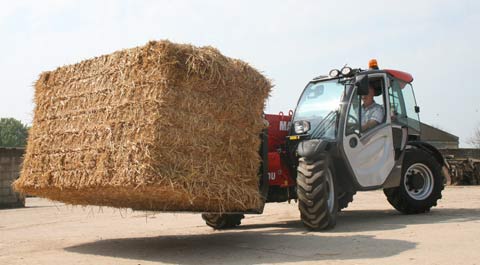Driven: Manitou MLT625 telehandler

A compact machine with a good amount of power. Suprisingly high-tech, too.
Telehandlers used to feature mainly on larger mixed and arable farms, rather than smaller livestock units. But there’s recently been a trend for manufacturers to offer a compact model with big-machine performance that can weave in and out of tight spaces while still being man enough to fill the diet feeder.
The new Manitou MLT625T is the latest example of the trend. It joins the French company’s existing construction sector-biased MT625, but gains bigger, 18 inch wheels, a beefier twin-radiator cooling pack and a reversible fan for dusty agricultural conditions. The two 625 models actually replace the MLT523, a machine that catered for both construction and agriculture.
Although designed for small spaces and measuring just 2m high by 1.82m wide, the 625 has a 5.9m maximum lift height and can lift 2.5t to 4.5m. That means it can manoeuvre round tight cattle yards and sheds and also stack straw, load muckspreaders and even fill the odd grain trailer.
Other key attributes are an ability to lift 800kg at its full 3.3m boom extension, a ground clearance of 38cm and tight turning circle of 3.19m (from outer wheel to outer wheel).
| Engine | 75hp 4-cylinder Kubota turbo |
| Lift height | 5.9m |
| Lift capacity | 2.5t |
| Hydraulics | 90 litres/min; 235 bar |
| Price | £43,333 (Premium spec) |
Powered by a 75hp four-cylinder Kubota engine, this small but (nearly) perfectly formed machine has far more poke than you’d expect. The last 523s, which came with 65hp Perkins powerplants, then Kubota ones, had a bulbous backend, which some users found hindered visibility.
In the cab, you could be forgiven for thinking you’re in a larger machine. Manitou’s joystick-switch-and-move (JSM) control system is handed down from bigger models and allows operators to control the machine with just the right hand. A toggle thumbswitch gives you forward, neutral and reverse, the joystick operates boom lift and lower as well as tilt, and rollers activate auxiliary attachments and Manitou’s hitch attachment system.
Up front, Manitou’s Easy Connect electronic button is handily positioned for operators putting on and off attachments and allows the system to be depressurised without having to get into the cab and waggle the switches. The 625T is fitted with a 25kph two-stage hydrostatic transmission and transport speed isn’t the zippiest. However, given the tasks this machine is likely to be faced with, it’s probably not a priority. It is possible to change ranges on the move, though.
Although an inching pedal is built into the brake pedal, it’s hydrostatically driven, so as soon as you take your foot off the throttle the machine comes to a stop. In fact, the brake pedal cuts all drive to the wheels instantly, regardless of how heavily you put your foot down. Meanwhile, the return oil from the hydrostatic driveline is used to reverse the radiator fan automatically for 15 seconds every three minutes to blow out dust and straw.
Manitou says the futuristic new cab design, with its one-piece, steel-frame door, is th same one as used on its construction sector machines. The window itself still opens out and pins back in the style of a traditional split door.
A new dashboard now encompasses the EN15000 safety system as well as a handy self-diagnostic system which allows you to look up a code and identify an operating fault.
Two spec levels are available and Manitou UK will be marketing the Premium spec in the UK. This comes as standard with air-con, hydraulic locking, reversible fan, air seat, Easy Connect System and MP3 radio.
Although there’s no hitch yet, this is expected to be an option in the next 12 months, and towing capacity is likely to be more than 4.5t. The MLT625T goes into production in September, but Manitou says dealer demos are available now.
Since October 2010, every new telehandler has had to be equipped with a system to ensure the operator adheres to safe working load limits. To put it simply, the load indicator in the corner of the cab now regulates the machine’s performance.
All manufacturers will have their own system for meeting these regulations (for more details, see next week’s issue). Manitou’s solution is to have three modes: handling, bucket and suspended load. However, when the boom is fully retracted, there are no restrictions.
The load indicator, located on the right-hand side of the dash, has three green lights, two amber ones and two red ones. A third red light flashes when the load is at the maximum limit of the load chart and an audible warning sounds.
Handling mode When the machine reaches its maximum limit, it shuts off all hydraulic movement, apart from lifting and retracting the boom. You can override it, but only by holding down a switch on the right-hand-side console and using your other hand to operate the JSM console. This only works for 60 seconds, after which it can be used again, but only if it’s repeatedly pressed.
Bucket mode If the limit is reached, it’s possible to lift and retract the boom again, as well as crowd, tilt and operate the auxiliary service before having to rely on the override button.
Suspended load This setting is designed for transporting swinging loads such as fertiliser bags. It moderates machine capacity to ensure longitudional stability when travelling up and down slopes. However, when the boom is fully retracted the load moment indicator is deactivated as EN15000 only applies when the boom is extended.
To re-set it, simply push and hold the button on the dash for two seconds. It will default back to the handling mode unless you’ve left it in the suspended load setting, in which case it will remain in action regardless of whether you turn the engine off or not.

